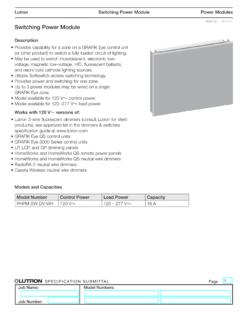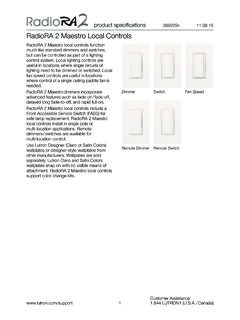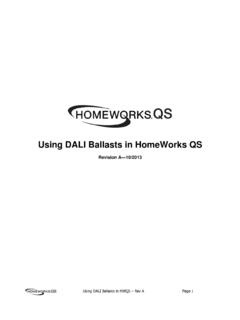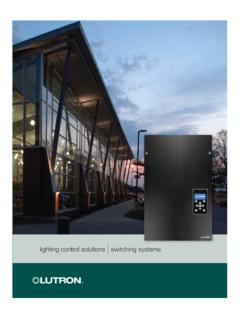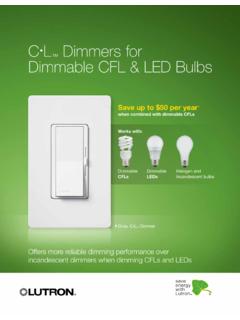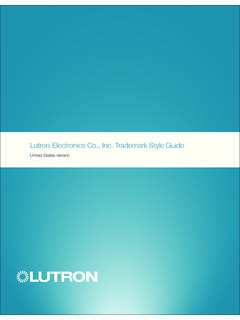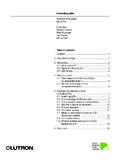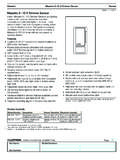Transcription of Wiring and Power Guidelines - Lutron Electronics
1 Wiring and Power Guidelines Revision I. Wiring and Power Guidelines Rev I Page 1. Overview The Wiring of a HomeWorks QS system has been made simpler through a reduction in the number of link types and a higher capacity of device addresses on each link compared to previous HomeWorks systems. The purpose of this document is to provide Guidelines for how to wire and Power HomeWorks QS devices. Processor / Network Link: Each HomeWorks QS processor has two RJ-45 Ethernet ports connected by an internal network switch. The Ethernet ports are used to connect processors together in a multi-Processor project, to connect Processors to the home network or other systems for integration, and to connect Processors to the HomeWorks QS software utility for activation, transfer and diagnostics.
2 In a multi-Processor project, each Processor must be connected to the same local area network (LAN) for proper system operation. To provide for the most flexibility in network architecture, Ethernet cable should be run: 1. Between each processor and the home LAN or router. 2. Between each processor location in the home. Having this Ethernet Wiring in place will allow the Processor / Network Link to be connected in a variety of possible configurations, as described in the Residential Systems Networking Guide. Each network configuration has different benefits, but Wiring in this method provides the most flexibility, especially since the home's networking hardware and software configurations may change over time.
3 Please refer to the Residential Systems Networking Guide for more information. Wiring and Power Guidelines Rev I Page 2. Configurable Links: Each HomeWorks QS Processor has two RS-485 configurable links that can be individually defined to be one of five types: HomeWorks Power Panel Link (16 MI addresses / 256 zones). o Module Interfaces (MI) and Remote Power Modules (RPM). HomeWorks QS RF Link (100 devices / 100 zones). o Dynamic Keypad, Maestro style Dimmers/Switches, Lamp Dimmers and Plug-in Devices, RF. seeTouch Keypads, RF Sensors Occupancy / Vacancy and Temperature, Sivoia QS Wireless Shades, seeTouch Tabletop Keypads, GRAFIK Eye QS Main Units, Wallbox Power Modules, GRAFIK.
4 T dimmers, switches and Hybrid keypads HomeWorks QS Wired Device Link (100 devices / 500 zones). o Control Interfaces, Dynamic Keypad, wired seeTouch Keypads, GRAFIK Eye QS Main Units, Sivoia QS. shades, Wallbox Power Modules, Palladiom keypads HomeWorks Wired Maestro/QED Shade (H48/Q96) Link (4 H48/Q96 Interfaces / 192 Wired Maestro devices/256 Wired QED Shades). o HWI-H48 Wired Maestro Interfaces and Wired Maestro Dimmers, Switches, and Fan Controls o Legacy QED shades HomeWorks Legacy Keypad Link (32 devices). o Keypads, HWI CCO Interfaces, HWI CCI Interfaces The link capacities shown above are the number of logical link addresses or devices that can be controlled on the link.
5 In addition, you must be sure that the Power requirements of the devices on each link are planned. HomeWorks Power Panel Link: HomeWorks / HomeWorks QS Power Panels, Module Interfaces and Remote Power Modules are powered by line-voltage feeds, and therefore do not get powered from the link. Module Interfaces are connected to the Processor on either link when configured as a Power Panel Link. The same standard Lutron 4- conductor cable (GRX-CBL-346S) that has been used in previous versions of HomeWorks can be used. This cable has one pair of 18-gauge and one pair of 22-gauge twisted/shielded conductors. Pin 2 should not be connected to the processor or Module Interfaces, as the Power is supplied to the MI from a separate 24V~ transformer included with the MI.
6 The Power Panel Link Wiring can be daisy-chained from one MI to the next and has a limit of 1000 feet of total wire length. For links configured as HWQS Power Panel , LT-1a link terminators must be installed across terminals 3 and 4 at both ends of the daisy chain link when the total Wiring exceeds 50 feet. Refer to the HomeWorks Power Panel Link example on page 13. Wiring and Power Guidelines Rev I Page 3. HomeWorks QS RF Link: HomeWorks QS RF Link devices are often powered by line-voltage, as is the case with dimmers; by a local Power supply, as is the case with Sivoia QS Wireless Shades or RF Dynamic Keypads; by batteries, as is the case with Radio Powr Savr sensors and Pico Wireless Controls.
7 These devices do not get wired to the RF. link. Hybrid Repeaters are required to enable RF communication in HomeWorks QS, and at least one Hybrid Repeater must be wired to each RF Link configured on the processor. Each additional Hybrid Repeater (up to 4 total Hybrid Repeaters per link) can be wired to the Processor RF Link, placed within 60 feet of another Hybrid Repeater (wireless), or wired to the RF Link on another Hybrid Repeater. Each Hybrid Repeater can be powered by the RF link on the processor (24 VDC) or by a 9 VDC plug-in transformer. The three main Power and Wiring options are: 1. Wired to RF Link for Power and communication 2. Wired to RF Link for communication, locally powered 3.
8 RF communication, locally powered Refer to the HomeWorks QS RF Link example on page 14. Lutron standard 4-conductor cable (GRX-CBL-346S) can be used with a maximum length of 1000 ft per wire run. Sivoia QS Wireless shades are most often powered locally by individual plug-in (QSPS-P1-1-35V) or junction-box (QSPS-J-1-50) Power supplies. Sivoia QS Wireless shades can also be powered by the ten- output smart Power panel (QSPSY-10 PNL), if the Wiring is practical. Each Sivoia QS Wireless shade requires its own RF Receiver, regardless of how the shade is powered. Radio Powr Savr Sensors and Pico Wireless Controls are battery powered and do not require any Wiring . Tabletop Keypads can also run on battery Power or be powered locally with a 9 VDC plug-in transformer.
9 Wiring and Power Guidelines Rev I Page 4. HomeWorks QS Wired QS Device Link: HomeWorks QS Wired QS Device Links consist mainly of devices that are powered by the QS Wired Link or dedicated Power supplies and therefore the Wiring and Power requirements must be planned carefully. The Power draw of each device is represented in Power Draw Units, or PDUs. The table at the end of this document defines the PDU count for the various wired devices. Refer to page 15 for the HomeWorks QS Wired QS Device Link example. Wired seeTouch Keypads, wired Dynamic Keypads, and interface devices all draw Power from the QS. Wired Link. Lutron standard 4-conductor cable (GRX-CBL-346S) can be used to wire these devices.
10 The QS Wired Link can be wired in daisy-chain, T-Tap, or star configurations, with a maximum wire length of 2000 feet per link. For ease of Wiring , Wire Landing Boards (QS-WLB) can be used to land wire in the processor enclosure or a separate enclosure. Additionally, QS Smart Panels (QSPS-10 PNL) can be used to distribute Power and provide multiple wire connections. Pin 2 should not be connected to GRAFIK Eye QS main units and Wallbox Power Modules, as these devices source their own Power and do not require Power from the QS Link. Sivoia QS Wired shades can be powered locally by individual plug-in (QSPS-P1-1-35V) or junction-box (QSPS-J-1-50) Power supplies, or from the ten-output smart Power panel (QSPS-10 PNL).
